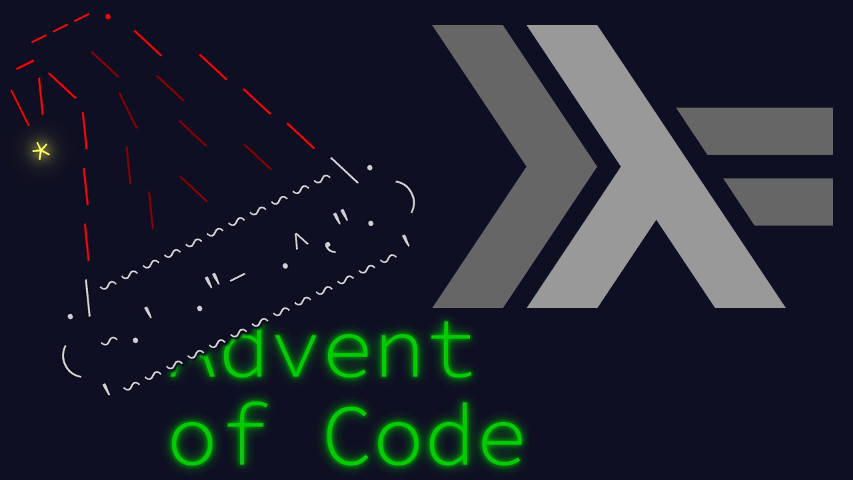If I’m not mistaken, Advent of Code day 6, “Guard Gallivant”, is the first grid walker of the year. Grid walker. What kind of a category is that? Well, It’s common enough in AoC. Let’s walk! Starting with a few imports, for the literate Haskell aspect of it.
import Control.Monad.ST (ST,runST)
import Data.Array (Array,listArray,bounds,indices,inRange,(!),(//))
import Data.Array.ST (STArray,getAssocs,newArray,readArray,writeArray)
import Data.Function (fix,on)
import Data.List (delete,find,groupBy)
import Linear.V2 (V2(V2))
type V = V2 IntYou’ll excuse me for sneaking a type along with the imports. Anyway,
the input is one of those typical 2D grids. In addition to mapping it
all to an array, we’ll isolate the starting position ^. The
starting direction is always “up”, no need to get any more fancy than
needed there.
parse :: String -> (Array V Char,V)
parse s = (grid,startPos) where
raw = lines s
h = length raw
w = length (head raw)
grid = listArray (V2 1 1,V2 h w) (concat raw)
Just startPos = find ((== '^') . (grid!)) (indices grid)I’m using a sinple 0–3 integer to encode direction.1 0 is the starting “up” direction, and there’s only one possible operation on them, namely… well, you get the picture.
dirs :: Array Int V
dirs = listArray (0,3) [V2 (-1) 0,V2 0 1,V2 1 0,V2 0 (-1)]
turnRight :: Int -> Int
turnRight = (`mod` 4) . succLet’s now implement the workhorse.
Oh wait. I haven’t talked about that yet, have I?
The big deal today is following the path from that ^
starting position, walk straight ahead until we ever encounter a
#, in which case we bump and turn right. Hence the function
above.
So let’s implement the actual walking.
Which such a setup, there’s only two reasonable outcomes.
data Result a = Exit a | LoopLet’s patrol this out!
patrol :: Patrol a => Array V Char -> V -> a
patrol grid startPos = runST $ do
let startDir = 0
(a,b) = bounds gridAs we said earlier, the starting direction is known and constant. I’ll implement the patrolling in a standard graph-traversal style, with a closed set to remember where we’ve been before and avoid looping.
closed <- newArray ((a,0),(b,3)) FalseThe rest is your standard traversal, nothing specific but the daily special of turning right when bumping into something.
flip fix (startPos,startDir) $ \loop (p,v) -> do
prev <- readArray closed (p,v)
if prev
then report Loop
else do
writeArray closed (p,v) True
let p' = p + dirs!v
if (inRange (bounds grid) p')
then if grid!p' == '#'
then loop (p,turnRight v)
else loop (p',v)
else report (Exit closed)I used a typeclass to weasel my way out of making it clear what that patrolling function should actually return.
class Patrol a where
report :: Result (STArray s (V,Int) Bool) -> ST s aIn part 1, we want to know the number of grid positions the guard will cover while patrolling.
So what I’m interested in is the set (reified as a list because I’m merely interpreting the traversal’s “closed” set) of walked positoins.
instance Patrol [V] where
report (Exit a) =
map (fst . fst . head)
. filter (or . map snd)
. groupBy ((==) `on` (fst . fst))
<$> getAssocs aThose composed fst and snd are a bit of a
pain. The gist is: we parse the closed set (getAssocs a),
group them by first index (namely position; the second index as
implemented above would be direction), keep only those that have
actually been patrolled through (or . map snd), keep an
actual position out of it (fst . fst).
Looping in part 1 shouldn’t happen, so I’m logging an error there for branch completeness’s sake, but it isn’t used in real life.
report Loop = error "Loop."That’s it, right? A bit of wrapping, and we solve part 1 with flying colors!
main :: IO ()
main = do
(grid,startPos) <- parse <$> getContents
let pathPoss = patrol grid startPos
print (length pathPoss)For part 2, we square out the complexity. We’re counting the number
of grid positions we can drop an obstacle on, that would result in the
guard entering a loop. So we’ll use that report function
again, this time returning a simple boolean out of it (reproduced later
as our literate Haskell is currently still in the middle of
main).
The number of positions we could drop an obstacle that would even be noticed by the guard isn’t that much smaller than the total grid size. About 25% in my input’s case. Bah, we’ve computed it, might as well re-use it.
let obstaclePoss = delete startPos pathPossThe main operation from part 1 becomes an iteration step in part 2:
let hasLoop obstaclePos = patrol (grid // [(obstaclePos,'#')]) startPosAnd that’s it! Report it and the star is ours.
print $ length $ filter hasLoop obstaclePoss
instance Patrol Bool where
report (Exit _) = pure False
report Loop = pure TrueThis concludes day 6’s problem. See you tomorrow!
I’ve been through a lot more while solving for this, but this was my best compromise.↩︎



